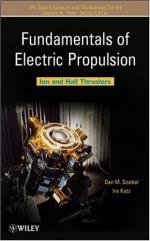|
This section contains 575 words (approx. 2 pages at 300 words per page) |

|
Ion propulsion is a method of propulsion that uses electrical rather than chemical forces to generate thrust for a spacecraft. Although less powerful than chemical engines, ion propulsion engines are more efficient and can be used continuously for long periods, making them ideal for deep space missions. The concept of ion propulsion has existed for many years, but only recently have ion engine-driven spacecraft been flown.
Ion propulsion works by taking advantage of the very strong repulsive force between two objects with the same electric charge. A cathode emits a stream of electrons that collides with neutral atoms of xenon, a gaseous element, in a chamber. The collisions strip the xenon atoms of one or more electrons, converting these atoms into positively charged ions. The xenon ions drift toward a pair of grids, one positively charged and one negatively charged, in back of the chamber. Once...
|
This section contains 575 words (approx. 2 pages at 300 words per page) |

|


